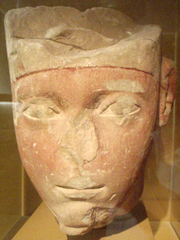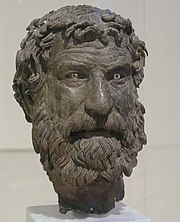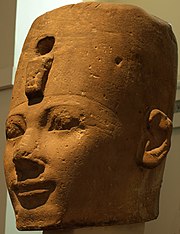Portal:Ancient Egypt/Selected biography
| This Wikipedia page has been superseded by Portal:Ancient Egypt and is retained primarily for historical reference. |
| Note: Article entries are now being transcluded directly on the main portal page. However, this page should be retained for historical reference. |
Selected biography 1
Portal:Ancient Egypt/Selected biography/1

Akhenaten was a Pharaoh of the Eighteenth Dynasty of Egypt, ruled for 17 years and died in 1336 BC or 1334 BC. He is especially noted for abandoning traditional Egyptian polytheism and introducing worship centered on the Aten, which is sometimes described as monotheistic or henotheistic. An early inscription likens him to the sun as compared to stars, and later official language avoids calling the Aten a god, giving the solar deity a status above mere gods.
Akhenaten tried to bring about a departure from traditional religion, yet in the end it would not be accepted. After his death, traditional religious practice was gradually restored, and when some dozen years later rulers without clear rights of succession from the Eighteenth Dynasty founded a new dynasty, they discredited Akhenaten and his immediate successors, referring to Akhenaten himself as 'the enemy' in archival records.[1]
He was all but lost from history until the discovery, in the 19th century, of Amarna, the site of Akhetaten, the city he built for the Aten. Early excavations at Amarna by Flinders Petrie sparked interest in the enigmatic pharaoh, which increased with the discovery in the Valley of the Kings, at Luxor, of the tomb of King Tutankhamun, who has been proved to be Akhenaten's son according to DNA testing in 2010 by Dr Zahi Hawaas, Cairo. Akhenaten remains an interesting figure, as does his Queen, Nefertiti. Their modern interest comes partly from his connection with Tutankhamun, partly from the unique style and high quality of the pictorial arts he patronized, and partly from ongoing interest in the religion he attempted to establish.
References
- ^ Trigger et al. (2001), pp.186-7
Selected biography 2
Portal:Ancient Egypt/Selected biography/2

Amenhotep I (sometimes read as Amenophis I and meaning "Amun is satisfied") was the second Pharaoh of the Eighteenth Dynasty of Egypt. His reign is generally dated from 1526 to 1506 BC. He was born to Ahmose I and Ahmose-Nefertari, but had at least two elder brothers, Ahmose-ankh and Ahmose Sapair, and was not expected to inherit the throne. However, sometime in the eight years between Ahmose I's 17th regnal year and his death, his heir apparent died and Amenhotep became crown prince. He then acceded to the throne and ruled for about 21 years.
Although his reign is poorly documented, it is possible to piece together a basic history from available evidence. He inherited the kingdom formed by his father's military conquests and maintained dominance over Nubia and the Nile Delta, but probably did not attempt to keep power in Syria-Canaan. He continued to rebuild temples in Upper Egypt, and revolutionized mortuary complex design by separating his tomb from his mortuary temple, setting a trend which would persist throughout the New Kingdom. After his death, he was deified into the patron god of Deir el-Medina.
Amenhotep was deified upon his death and made the patron deity of the village which he opened at Deir el-Medina. His mother, who lived at least one year longer than he did, was also deified upon her death and became part of his litany. When being worshiped, he had three deific manifestations: "Amenhotep of the Town," "Amenhotep Beloved of Amun," and "Amenhotep of the Forecourt," and was known as a god who produced oracles. Some of the questions asked of him have been preserved on ostraca from Deir el-Medina, and appear to have been phrased in such a way that the idol of the king could nod (or be caused to nod) the answer.
Selected biography 3
Portal:Ancient Egypt/Selected biography/3

Ahmose I (sometimes written Amosis I, "Amenes" and "Aahmes" and meaning Born of the Moon or Born of Yah) was a pharaoh of ancient Egypt and the founder of the Eighteenth Dynasty. He was a member of the Theban royal house, the son of pharaoh Tao II Seqenenre and brother of the last pharaoh of the Seventeenth Dynasty, King Kamose. During the reign of his father or grandfather, Thebes rebelled against the Hyksos, the rulers of Lower Egypt. When he was seven his father was killed, and he was about ten when his brother died of unknown causes, after reigning only three years. Ahmose I assumed the throne after the death of his brother, and upon coronation became known as Neb-Pehty-Re (The Lord of Strength is Re).
During his reign, he completed the conquest and expulsion of the Hyksos from the delta region, restored Theban rule over the whole of Egypt and successfully reasserted Egyptian power in its formerly subject territories of Nubia and Canaan. He then reorganized the administration of the country, reopened quarries, mines and trade routes and began massive construction projects of a type that had not been undertaken since the time of the Middle Kingdom. This building program culminated in the construction of the last pyramid built by native Egyptian rulers. Ahmose's reign laid the foundations for the New Kingdom, under which Egyptian power reached its peak. Ahmose I's mummy was discovered in 1881 within the Deir el-Bahari Cache, located in the hills directly above the Mortuary Temple of Hatshepsut. He was interred along with the mummies of other 18th and 19th dynasty leaders Amenhotep I, Thutmose I, Thutmose II, Thutmose III, Ramesses I, Seti I, Ramesses II and Ramesses IX, as well as the 21st dynasty pharaohs Pinedjem I, Pinedjem II and Siamun. His reign is usually dated to about 1550–1525 BC. His mummy is now in the Luxor Museum alongside the purported one of Ramesses I, as part of a permanent exhibition called "The Golden Age of the Egyptian Military".
Selected biography 4
Portal:Ancient Egypt/Selected biography/4

Philitas of Cos (c. 340–c. 285 BC) was a scholar and poet during the early Hellenistic period of ancient Egypt. A Greek associated with Alexandria, he flourished in the second half of the 4th century BC and was appointed tutor to the heir to the throne of Ptolemaic Egypt. He was thin and frail; Athenaeus later caricatured him as an academic so consumed by his studies that he wasted away and died.
Philitas was the first major writer who was both a scholar and a poet. His reputation continued for centuries, based on both his pioneering study of words and his verse in elegiac meter. His vocabulary Disorderly Words described the meanings of rare literary words, including those used by Homer. His poetry, notably his elegiac poem Demeter, was highly respected by later ancient poets. However, almost all his work has since been lost. The 1st century AD rhetorician Quintilian ranked Philitas second only to Callimachus among the elegiac poets. Philitas' influence has been found or suspected in a wide range of ancient writing; Longus' 2nd century AD novel Daphnis and Chloe contains a character likely named after him. Hermesianax wrote of "Philitas, singing of nimble Bittis", and Ovid twice calls her "Battis". It is commonly thought that Bittis or Battis was Philitas' mistress, and that Hermesianax referred to love poetry; another possibility is that her name connoted "chatterbox", and that she was a humorous personification of Philitas' passion for words. Almost all that he wrote seems to have disappeared within two centuries, though, so it is unlikely that any writer later than the 2nd century BC read any but a few of his lines.
Selected biography 5
Portal:Ancient Egypt/Selected biography/5

Darius I, known as Darius the Great, was the third "king of kings" (emperor) of the Achaemenid Empire. Darius held the empire at its peak, then including Egypt, northern India, and parts of Greece. The decay and downfall of the empire commenced with his death and the coronation of his son, Xerxes I.
Darius ascended the throne by assassinating the alleged usurper Bardiya with the assistance of six other Persian noble families; Darius was crowned the following morning. The new emperor met with rebellions throughout his kingdom, and quelled them each time. A major event in Darius's life was his expedition to punish Athens and Eretria for their aid in the Ionian Revolt and subjugate Greece. Darius expanded his empire by conquering Thrace and Macedon, and invading the Saka, Iranian tribes who had invaded Medes and had previously killed Cyrus the Great.
Darius organized the empire, by dividing it into provinces and placing governors to govern it. He organized a new uniform monetary system, along with making Aramaic the official language of the empire. Darius also worked on construction projects throughout the empire, focusing on Susa, Pasargadae, Persepolis, Babylon, and Egypt. Darius created a codification of laws for Egypt. He also carved the cliff-face Behistun Inscription, an autobiography of great modern linguistic significance. After becoming aware of the Persian defeat at the Battle of Marathon, Darius began planning another expedition against the Greek-city states. Darius had spent three years preparing men and ships for war when a revolt broke out in Egypt. This revolt in Egypt worsened his failing health and prevented the possibility of leading another army himself; soon, Darius was dead. In October 486 BC, the body of Darius was embalmed and entombed in the rock-cut sepulcher which had been prepared for him several years earlier.
Selected biography 6
Portal:Ancient Egypt/Selected biography/6

Artaxerxes III (Ca. 425 BC – 338 BC) was the Great King (Shah) of Persia and the eleventh Emperor of the Achaemenid Empire and the first Pharaoh of the 31st dynasty of Egypt. He was the son and successor of Artaxerxes II and was succeeded by his son, Arses of Persia (also known as Artaxerxes IV). His reign coincided with the reign of Philip II in Macedon and Nectanebo II in Egypt.
Before ascending the throne Artaxerxes was a satrap and commander of his father's army. Artaxerxes came to power after one of his brothers was executed, another committed suicide, the last brother was murdered and his father, Artaxerxes II died at the age of 86. Soon after becoming king, Artaxerxes murdered all of the royal family to secure his place as emperor. He started two major campaigns against Egypt. The first campaign failed, and was followed up by rebellions throughout the western empire. In 343 BC, Artaxerxes defeated Nectanebo II, the Pharaoh of Egypt, driving him from Egypt, stopping a revolt in Phoenicia on the way.
In Artaxerxes' later years, Philip II of Macedon's power was increasing in Greece, where he tried to convince the Greeks to revolt against Achaemenid Persia. His activities were opposed by Artaxerxes, and with his support, the city of Perinthus resisted a Macedonian siege. There is evidence for a renewed building policy at Persepolis in his later life, where Artaxerxes erected a new palace and built his own tomb but projects like the Unfinished Gate. According to a Greek source, Diodorus of Sicily, Bagoas poisoned Artaxerxes, but a cuneiform tablet (now in the British Museum) suggests that the king died from natural causes.
Selected biography 7
Portal:Ancient Egypt/Selected biography/7

Thutmose I (sometimes read as Thothmes, Thutmosis or Tuthmosis I) was the third Pharaoh of the Eighteenth Dynasty of Egypt. He was given the throne after the death of the previous king Amenhotep I. During his reign, he campaigned deep into the Levant and Nubia, pushing the borders of Egypt further than ever before. He also built many temples in Egypt and built a tomb for himself in the Valley of the Kings; he is the first king confirmed to have done this (though Amenhotep I may have preceded him). He was succeeded by his son Thutmose II, who in turn was succeeded by Thutmose II's sister, Hatshepsut. His reign is generally dated from 1506 to 1493 BCE. Thutmose I's mummy was ultimately discovered in the Deir el-Bahari Cache above the Mortuary Temple of Hatshepsut, revealed in 1881. He had been interred along with those of other 18th and 19th dynasty leaders Ahmose I, Amenhotep I, Thutmose II, Thutmose III, Ramesses I, Seti I, Ramesses II, and Ramesses IX, as well as the 21st dynasty pharaohs Pinedjem I, Pinedjem II, and Siamun. The original coffin of Thutmose I was taken over and re-used by a later pharaoh of the 21st dynasty. The mummy of Thutmose I was thought to be lost, but Egyptologist Gaston Maspero, largely on the strength of familial resemblance to the mummies of Thutmose II and Thutmose III, believed he had found his mummy in the otherwise unlabelled mummy #5283. This identification has been supported by subsequent examinations, revealing that the embalming techniques used came from the appropriate period of time, almost certainly after that of Ahmose I and made during the course of the Eighteenth Dynasty.
